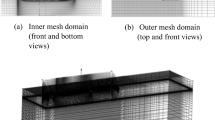Abstract
This paper numerically investigates the influence of separation variation of the outriggers on the hydrodynamic performance of a high speed trimaran (HST) aiming at improving its applicability in diverse realistic disciplines. The present investigation was performed within the framework of the 2-D slender body method (SBM) by calculating the resistance of three symmetric trimaran series moving in a calm free surface of deep water. Each trimaran series comprises of 4681 configurations generated by considering 151 staggers (−50%≤α≤+100%), and 31 separations (100%≤β≤400%) for 81 Froude numbers (0.20≤F n ≤1.0). In developing the three trimaran series, Wigley©-st, AMECRC©-09, and NPL©-4a models were used separately for both the main and side hulls of each individual series models. A computer macro named Tri-PL© was created using the Visual Basic for Applications©. Tri-PL© sequentially interfaced Maxsurf© then Hullspeed© to generate the models of the three trimaran series together with their detailed hydrostatic particulars, followed by their resistance components. The numerical results were partially validated against the available published numerical calculations and experimental results, to benchmark the Tri-PL© macro and hence to rely on the analysis outcomes. A graph template was created within the framework of SigmaPlot© to visualize the significant results of the Tri-PL© properly.
Similar content being viewed by others
References
Bailey D (1976). The NPL High speed round bilge displacement hull series. marine technology monograph. The Royal Institute of Naval Architects (RINA), 4.
Batchelor G (1959). A proposal concerning wakes behind bluff bodies at large Reynolds numbers. Journal of Fluid Mechanics, 6, 547–567.
Bojovic P (1995). AMECRC Systematic series calm water testing results. Australian Maritime Engineering Cooperative Research Centre, Report AMECRC IR 95/5, 1-93.
Bojovic P, Goetz G (1996). Geometry of AMECRC systematic series. Australian Maritime Engineering Cooperative Research Centre, Report AMECRC IR 96/6, 1-37.
Cone CD (1963). The aerodynamic design of wings with cambered span having minimum induced drag. Langley Research Center, Virginia, United States, NASA Technical Report No. TR R-152.
Couser P, Wellicome J, Molland A (1998). An improved method for the theoretical prediction of the wave resistance of transom-stern hulls using a slender body approach, International Shipbuilding Progress, 45(444).
Doctors L (1995). A practical method of prediction of ship resistance for displacement vessels. International Symposium on Practical Design of Ships and Mobile Units (PRADS’95), Society of Naval Architects of Korea, Korea, 1, 648–659.
Doctors L, Day A (1997). Resistance prediction for transom-stern vessels. International Conference on Fast Sea Transportation (FAST’97), Australia, 2, 743–750.
Doctors L, Beck R (2005). The separation of the flow past a transom stern. International Conference on Marine Research and Transportation (ICMRT’05), Italy, 14.
Doctors L (2006). Investigation of the free-surface and resistance of transom-stern vessels. Pacific International Maritime Conference (PIMC’06), Australia, 196–205.
Doctors L (2006). Influence of the transom-hollow length on wave resistance. International Workshop on Water Waves and Floating Bodies (IwwwFB’21), England, 4.
Eggers K (1955). Resistance components of two-body ships, Jahrbuch der Schiffbautechnischen Gesellschaft, 49.
Hanhirova K, Rintala S, Karppinen T (1995). Preliminary resistance prediction method for fast mono-and-multihull vessels. International Symposium on High Speed Vessels for Transport and Defence, Royal Institution of Naval Architects (RINA), England, 6, 1–17.
Hullspeed© (2011). Formation Design Systems Pty Ltd., Available at: http://www.formsys.com/.
Insel M (1990). An investigation into the resistance components of high speed displacement catamarans, Ph. D. thesis, University of Southampton.
Marwood W, Bailey D (1969). Design data for high-speed displacement hulls of round-bilge form. Ship Report 99, National Physical Laboratory.
Maxsurf© (2011). Formation Design Systems Pty Ltd., Available at: http://www.formsys.com/.
Michell J (1898). The wave resistance of a ship. Philosophical Magazine, England, 5(45), 106–123.
Michlet© (2010), Wave resistance prediction software, Available at: http://www.cyberiad.net.
Mynard T, Sahoo P, Mikkelsen J, McGreer D (2008). Numerical and experimental study of wave resistance for trimaran hull forms. Australian Maritime College, Australia, 117–132.
Newman J (1999). Marine hydrodynamics. The Massachusetts Institute of Technology (MIT) Press.
Robards S, Doctors L (2003). Transom-hollow prediction for high-speed displacement vessels. International Conference on Fast Sea Transportation (FAST’03), Italy, 1(A), 19–26.
ShipFlow©, flowtech international AB, Available at: http://www.flowtech.se/, Accessed, 2, 2011.
SigmaPlot© (2006). Systat Software Inc., Available at: http://www.systat.com/.
Sinha S (1981). Backward facing step flow experiments. AIAA Journal, 19, 1527–1530.
Tuck E, Luzauskas L, Scullen D (1999). Sea wave pattern evaluation. part 1 report: primary code and test results (Surface vessels), Applied Mathematics Department, the University of Adelaide.
Visual Basic for Applications© (2010). Microsoft© Corp., Available at: http://www.Microsoft.com/.
Wehausen J, Laitone E (1960). Surface waves. Encyclopedia Of Physics, 9, Berlin-Gottingen-Heidelberg, Springer-Verlag.
Wehausen J (1971). The motion of floating bodies. Annual Revision of Fluid Mechanics, 3, 237–268.
Wigley W (1934). A comparison of experimental and calculated wave profiles and wave resistances for a form having parabolic waterlines. Royal Society London, Ser. A, 144(851), 144–159.
(1957). Skin friction and turbulence. International Towing Tank Conference (ITTC’57), Madrid.
Author information
Authors and Affiliations
Corresponding author
Additional information
Dr. Khaled Hafez: Ph. D. degree (2002) in Civil Engineering, Architecture and Marine Technology, Department of Naval Architecture and Ocean Engineering, Faculty of Engineering, Yokohama National University, Japan. M. Sc. degree (1995) and B. Sc. “Distinction with Honor degree” (1991) in Naval Architecture and Marine Engineering, Faculty of Engineering, Alexandria University, Egypt. Currently, an Assistant Prof. (Lecturer) at the Department of Naval Architecture and Marine Engineering, Faculty of Engineering, Alexandria University, Egypt. Interested in Hydro-elasticity of Marine Structures, Hydrodynamics of Marine Structures, Wave-Ship Interaction, Computational Fluid Dynamics (CFD), Computer-Aided Ship Design (CAD), Naval Architecture and Ocean Engineering.
Abdel-Rahman El-Kot: B. Sc. degree (2011) in Naval Architecture and Marine Engineering, Faculty of Engineering, Alexandria University, Egypt. Interested in Ship Hydrodynamics.
Rights and permissions
About this article
Cite this article
Hafez, K., El-Kot, AR. Comparative analysis of the separation variation influence on the hydrodynamic performance of a high speed trimaran. J. Marine. Sci. Appl. 10, 377–393 (2011). https://doi.org/10.1007/s11804-011-1083-0
Received:
Published:
Issue Date:
DOI: https://doi.org/10.1007/s11804-011-1083-0



